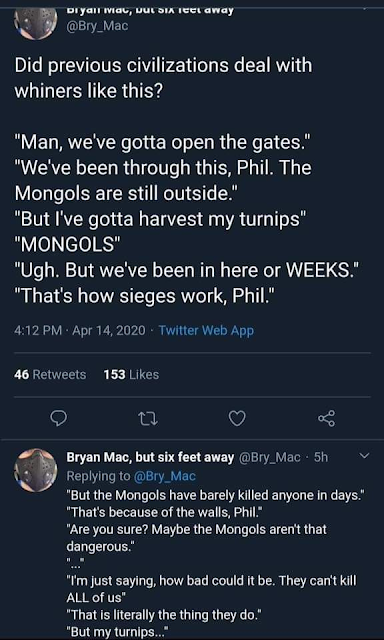"But the Mongols, Phil"
A year ago during the middle of the pandemic this clever tweet caught my attention. It reminded me of the wars between the Croats and the Mongols, and really all of Eastern Europe. The Mongols swept Kievan Rus, divided by its many feudal princes (much like the Poles would be nearly two hundred years later against the Turks). Russia, as a principality, didn't exist yet. But it would in the rebirth after the retreat to tiny, insignificant Muscovy, from formerly glorious, now a burned over and crushed cairn called Kiev. The Mongols continued afterwards. They flew into Hungary, then ruler of Croatia and much of modern Romania. The Hungarians, or Magyars, had originally been a nomadic tribe, much like the Mongols themselves. They had imposed themselves by terror on the Pannonian Plain. Now, however, they had grown soft. They had converted to Catholicism and settled down as agricultural farmers. Another people, the Cumans, had moved in and replaced them as the untrusted and hardened horseback archers. But as the King of Hungary attempted to bring them into his army against the approaching threat of the Mongols, something terrible happened. Much like the Bear River Massacre, or future massacres of nomadic horseback peoples such as the indigenous tribes of the Americas, something happened, and the knights of the realm massacred their only real hope against the invaders. It would be like if the Special Operations teams of today had murdered the skilled and hardened fighters of the Northern Alliance right before the invasion of Afghanistan in 2001, or the purge of Soviet officers before World War II. There are many examples of armies and peoples killing their last best hope of survival by killing, or exiling their most technically skilled and competent military leadership. Somehow they survive, nonetheless. I want to know how. How do you recover from a loss of good military leadership without pruning out the deadwood in a war of high-stakes national survival?
The first map is of the region in 814 AD. The second map is of Hungary and Croatia about 40 years before the terrifying invasion, in 1200 AD.
Credits Harvard WorldMap, 2021. Map Author, Logan Bolan. July 18th, 2021
Croatian cities, being independent, saw the move of the Mongol Horde as a threat to their independence. As the King of Hungary fled down the coast seeking shelter, the cities of Croatia refused him entry. Eventually, he came to what is now known as Split or SPLEET. They did not let him in, but put him on a barren island outside the city. The Mongols were lured into a swamp by the inhabitants of Split, and ambushed. That was the farthest the Mongols came west into Europe. They fled back on their horses, through thousands of miles of guerilla war, vengeful nations, and steppes. They also came back because their Great Khan, Ogodei Khan had died, and it was time to elect a new one in Mongolia, and the only way to win the horse trading for votes was to be there in person. So the Mongol General went home. Croatia, and Hungary were saved, but the Golden Horde endured for nearly three hundred more years, until the Russians under Ivan the Terrible, took up musketry, and put an end to the horseback archers once and for all with massed fire and an infantry square.
The Khans died out, but a new related threat emerged: The Ottoman Turks.




Comments
Post a Comment